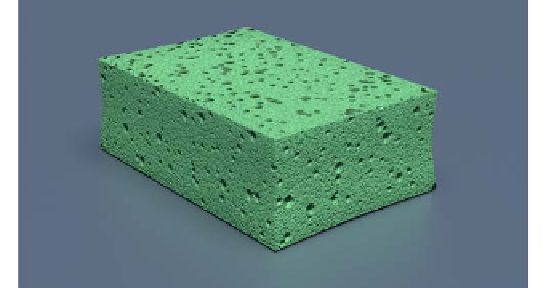Graphics Reference
In-Depth Information
Creating a synthetic sponge material with
procedurals
In this recipe, we will create a polyurethane sponge material (the type that you usually find in
kitchens), as shown in the following screenshot:
The synthetic sponge material when rendered
Getting ready
Follow these steps to create a synthetic sponge material with procedurals:
1.
Start Blender and switch to the Cycles Render engine.
2.
Select the default Cube, and in the Transform subpanel to the right of the 3D
viewport (under Dimensions), change the values of X to
0.350
, Y to
0.235
,
and Z to
0.116
. Press
Ctrl
+
A
to apply the scale.
3.
With the mouse arrow in the 3D viewport, add a Plane to the scene (press
Shift
+
A
and navigate to Mesh | Plane). Exit Edit Mode, and in the Transform subpanel (the
Dimensions item), set the values of X to
20.000
and Y to
20.000
. Press
Ctrl
+
A
to
apply the scale. Move the Plane down (press
G
, then press
Z
, enter
-0.05958
, and
then press
Enter
) to act as the floor for the sponge.
4.
Select the Lamp item. In the Object data window, click on the Use Nodes button
and change the type to Sun. Set the Size to
0.500
, Color to pure white, and the
Strength value to
5.000
. In the Transform panel, set the values of Rotation value
of X to
15°
, Y to
0°
, and Z to
76°
.
5.
Select the Camera item, and in the Object data window under the Lens subpanel,
change the Focal Length value to
60.000
. In the Transform subpanel, set the
values of the Location value of X to
0.82385
, Y to
-0.64613
, and Z to
0.39382
.
Change the Rotation values of X to
68°
, Y to
0°
, and Z to
51°
.






